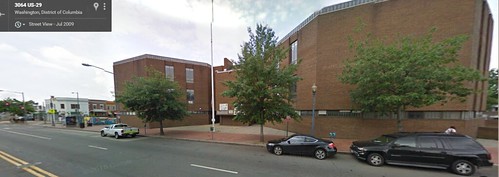 I think the school might have been an open classroom school. This design has been proven to be an ineffective way to organize an elementary school. Google Street View Image, 2009.
I think the school might have been an open classroom school. This design has been proven to be an ineffective way to organize an elementary school. Google Street View Image, 2009.I never wrote about it, but back when then Councilmember Jim Graham in Ward 1 was a leading proponent of both tearing down the deaccessioned Bruce-Monroe Elementary School ("Georgia Avenue School Demolished for Mixed-Use Project" DCMUD, 2009) at Georgia Avenue and Irving Street NW and replacing it with a "temporary park" I figured that down the road there would be great opposition to converting the property back to buildings.
The original plan was to rebuild the school. In the interim, students were shifted to the Park View Elementary School, a few blocks away.
While parks are a fine use, they aren't categorically the "highest and best use" everywhere and in every situation, including at key intersections along corridors.
From the standpoint of improving Georgia Avenue NW a 5-mile long corridor starting at U Street NW and ending at the DC-Maryland line in Montgomery County, it'd be better to add housing at that location, especially because the site is within one-half mile of the Georgia Avenue-Petworth Metro Station, and just a little further than that from the Columbia Heights Metro Station.
It would be in keeping with other multiunit housing development in the area ("Four condo buildings bring burst of redevelopment to District’s Park View," Washington Post).
The Washington Post reported on Monday ("D.C. residents: Plan to replace public housing will jeopardize popular park") that residents are opposing using the site for affordable housing in association with the replacement of the Park Morton housing project ("Renovations, Neighborhood Reviving Park Monroe," Washington Post, 2003).
Ironically, residents seem to have forgotten their earlier anger over the city's reneging on what they thought was an agreement to rebuild the school ("Community feels the pinch of school closing," A City Divided blog; "Unkept promises on a DC grade school," Washington Post).
A long time ago, local planner and blogger Dan Malouff made a comment on this blog (the comment is lost to an old blog comment system) that was very insightful. He made the point that maybe people don't want parks, but they'll always advocate for parks in face of development alternatives, to ward off development of any kind.
Community garden advocates at a rally on Tuesday on the plaza of City Hall. Credit William Alatriste for the New York Times.
2. It's often the same with community gardens ("In Community Gardens, a New Weed?," New York Times).
I got in an argument about a similar situation in DC ("Shouldn't places near subway stations, in intensely urban places, be urban?"). although the original comment thread is also lost to the ether.
3. And rails to trails, for example by the "Friends of the Capital Crescent Trail" organization in Montgomery County, Maryland. Probably most of the members of the group prefer no trail to a trail, but prefer a trail ("park") to having a light rail line in what they see as their backyards, but until the late 1980s had been a freight railroad line delivering coal to a DC electricity generation plant.
====
Note that I am not saying I am against parks, community gardens, or trails. Parks, community gardens, and trails (shared use paths) are critical elements in placemaking and complete systems of parks, cultural, and transportation assets.
I am saying that trails can co-exist with transit, and that depending on the circumstances, it'd be better in some situations to have housing rather than a park or community garden.
This is another instance of needing to be very clear about purpose and the long term objectives of the use of space. And processes in place to assist in making choices and decisions within constraints and conflicting goals and objectives.


hy
ReplyDeletethanks for sharing this blog
plz visit 123movies
hy
ReplyDeletethanks for sharing this blog
plz visit Best Landscapinng Company in India